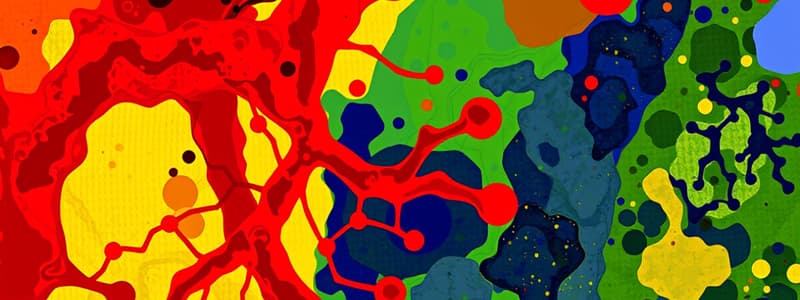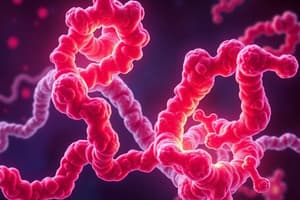Podcast
Questions and Answers
What is the primary function of cytochromes in relation to hemoproteins?
What is the primary function of cytochromes in relation to hemoproteins?
- Electron transport as oxidized or reduced proteins (correct)
- Reversibly bind O2 for storage
- Stabilize O2 binding to heme
- Break down H2O2
How many molecules of O2 can Hemoglobin A carry at a time?
How many molecules of O2 can Hemoglobin A carry at a time?
- 2 molecules
- 5 molecules
- 3 molecules
- 4 molecules (correct)
Which of the following accurately describes the structure of Hemoglobin A?
Which of the following accurately describes the structure of Hemoglobin A?
- Two alpha and two beta chains (correct)
- Four independent heme groups without chains
- Two alpha and two gamma chains
- Single polypeptide chain with heme group
What role do the proximal and distal sites play in hemoproteins?
What role do the proximal and distal sites play in hemoproteins?
What is the main function of hemoglobin in red blood cells?
What is the main function of hemoglobin in red blood cells?
What is the primary structural characteristic of Myoglobin?
What is the primary structural characteristic of Myoglobin?
Which amino acids are primarily found in the interior of the Myoglobin structure?
Which amino acids are primarily found in the interior of the Myoglobin structure?
What is the function of Myoglobin in muscle tissue?
What is the function of Myoglobin in muscle tissue?
Where is the heme group located in Myoglobin?
Where is the heme group located in Myoglobin?
What constitutes a primary characteristic of Methemoglobin?
What constitutes a primary characteristic of Methemoglobin?
Which of the following best describes the role of proline in Myoglobin's structure?
Which of the following best describes the role of proline in Myoglobin's structure?
What structural feature is essential for the allosteric effect in hemoglobin?
What structural feature is essential for the allosteric effect in hemoglobin?
Which hemoglobinopathy is characterized by an abnormal hemoglobin variant resulting in sickle-shaped red blood cells?
Which hemoglobinopathy is characterized by an abnormal hemoglobin variant resulting in sickle-shaped red blood cells?
What describes the T state of hemoglobin?
What describes the T state of hemoglobin?
Which of the following correctly represents the composition of hemoglobin?
Which of the following correctly represents the composition of hemoglobin?
What does the iron in heme bond to in addition to the porphyrin nitrogens?
What does the iron in heme bond to in addition to the porphyrin nitrogens?
What are the interactions that hold the quaternary structure of hemoglobin together?
What are the interactions that hold the quaternary structure of hemoglobin together?
What is the main characteristic of the R state of hemoglobin?
What is the main characteristic of the R state of hemoglobin?
How many bonds can iron form in the heme group?
How many bonds can iron form in the heme group?
What happens to the heme binding pocket during the transition from T state to R state?
What happens to the heme binding pocket during the transition from T state to R state?
The term deoxyhemoglobin refers to which state of hemoglobin?
The term deoxyhemoglobin refers to which state of hemoglobin?
Which statement accurately describes the primary difference in oxygen binding between myoglobin and hemoglobin?
Which statement accurately describes the primary difference in oxygen binding between myoglobin and hemoglobin?
What physiological conditions would shift the hemoglobin oxygen dissociation curve to the right?
What physiological conditions would shift the hemoglobin oxygen dissociation curve to the right?
What is the significance of the P50 value in the context of hemoglobin and myoglobin?
What is the significance of the P50 value in the context of hemoglobin and myoglobin?
What is the primary role of 2,3-biphosphoglycerate (2,3-BPG) in blood oxygen transport?
What is the primary role of 2,3-biphosphoglycerate (2,3-BPG) in blood oxygen transport?
Which factor does NOT contribute to the allosteric regulation of oxygen binding in hemoglobin?
Which factor does NOT contribute to the allosteric regulation of oxygen binding in hemoglobin?
How does the Bohr effect influence oxygen release from hemoglobin?
How does the Bohr effect influence oxygen release from hemoglobin?
Which of the following statements about the cooperative binding of hemoglobin is correct?
Which of the following statements about the cooperative binding of hemoglobin is correct?
What is the effect of lactic acid produced during anaerobic metabolism on hemoglobin's oxygen affinity?
What is the effect of lactic acid produced during anaerobic metabolism on hemoglobin's oxygen affinity?
How does carbon dioxide (CO2) primarily influence hemoglobin function?
How does carbon dioxide (CO2) primarily influence hemoglobin function?
Which mechanism explains the decrease in hemoglobin's oxygen affinity when 2,3-BPG binds?
Which mechanism explains the decrease in hemoglobin's oxygen affinity when 2,3-BPG binds?
What happens to the affinity of hemoglobin for oxygen under conditions of chronic hypoxia?
What happens to the affinity of hemoglobin for oxygen under conditions of chronic hypoxia?
How does the binding of carbon monoxide (CO) affect hemoglobin?
How does the binding of carbon monoxide (CO) affect hemoglobin?
What is the physiological consequence of decreased pCO2 levels on hemoglobin's function?
What is the physiological consequence of decreased pCO2 levels on hemoglobin's function?
What role does the heme-heme interaction play in hemoglobin's oxygen binding?
What role does the heme-heme interaction play in hemoglobin's oxygen binding?
Study Notes
Globular Hemeproteins
- Myoglobin located in heart and skeletal muscle, serves as an oxygen reservoir and carrier.
- Myoglobin features around 80% alpha helical content, consisting of a folded structure with eight alpha-helices (A-H), ending in proline.
Structure of Heme
- Composed of ferrous iron and protoporphyrin IX.
- Iron forms six bonds: four with porphyrin nitrogens, and two additional bonds - one to a histidine side chain and another for oxygen binding.
- Heme plays a critical role in globular hemeproteins including myoglobin and hemoglobin.
Structure and Function of Hemoglobin
- Found exclusively in red blood cells (RBCs).
- Functions to transport oxygen from lungs to tissues, alongside carbon dioxide and hydrogen.
- Hemoglobin consists of four polypeptide chains (2 alpha and 2 beta), enabling cooperative binding of oxygen.
Binding of Oxygen
- Myoglobin binds one heme and one oxygen molecule with higher affinity compared to hemoglobin, which binds four oxygen molecules.
- Oxygen-dissociation curve illustrates myoglobin’s hyperbolic binding compared to hemoglobin's sigmoidal curve.
Allosteric Effect
- Hemoglobin is influenced by allosteric effectors such as pO2, pH, pCO2, and 2,3-biphosphoglycerate (2,3-BPG).
- Cooperative binding in hemoglobin facilitates increased oxygen affinity as oxygen binds to successive heme sites.
Oxygen Dissociation and P50 Value
- P50 indicates the partial pressure of oxygen required to achieve half-saturation of binding sites: 1 mmHg for myoglobin and 26 mmHg for hemoglobin.
- Myoglobin shows hyperbolic shape in the oxygen dissociation curve; as oxygen is released, the binding behavior shifts right or left depending on oxygen levels.
Bohr Effect
- The release of oxygen occurs with decreased pH or increased pCO2, lowering hemoglobin's oxygen affinity and shifting the curve to the right.
- Higher pH or decreased pCO2 increases affinity, shifting the curve to the left, enhancing oxygen binding.
Role of 2,3-BPG
- 2,3-BPG is an important regulator of oxygen binding in hemoglobin, reducing oxygen affinity for greater unloading.
- Increased levels of 2,3-BPG occur during chronic hypoxia or anemia, allowing better oxygen release in tissues.
- Stored blood has low 2,3-BPG, resulting in high oxygen affinity, hence poor oxygen release during transfusions.
Binding of CO2 and CO
- Most CO2 in blood is converted to bicarbonate ion (HCO3) for transport; some binds to hemoglobin as carbamate at N-terminal amino group.
- Carbon monoxide (CO) binds tightly (restorably) to hemoglobin, forming carboxyhemoglobin with a greater affinity than oxygen, posing a risk to smokers.
- Treatment for CO poisoning includes hyperbaric oxygen therapy to promote dissociation of CO.
Summary of Oxygen Binding Changes
- Shift to the left in the oxygen dissociation curve indicates increased oxygen affinity (higher pH, lower pCO2, decreased 2,3-BPG).
- Shift to the right indicates decreased affinity (lower pH, increased pCO2, increased 2,3-BPG), aiding oxygen release in metabolically active tissues.
Studying That Suits You
Use AI to generate personalized quizzes and flashcards to suit your learning preferences.
Related Documents
Description
Explore the fascinating world of globular hemeproteins, focusing on myoglobin and hemoglobin. This quiz covers their structures, functions, and the critical role of heme in oxygen transport and storage in the body. Test your knowledge of these essential proteins.




